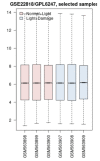Neuroprotective Properties of Photobiomodulation in Retinal Regeneration in Rats: Perspectives From Interaction Levels
- PMID: 32802288
- PMCID: PMC7369552
- DOI: 10.34172/jlms.2020.47
Neuroprotective Properties of Photobiomodulation in Retinal Regeneration in Rats: Perspectives From Interaction Levels
Abstract
Introduction: Photobiomodulation (PBM) is known as low-level laser (or light) therapy and is applied in different fields of medicine. However, it is required that its molecular and cellular mechanism be investigated. This study aims to assess the neuroprotective properties of PBM in the rat retina. Methods: GSE22818 was downloaded from Gene Expression Omnibus (GEO) and the regulation of the significant differentially expressed genes (DEGs) which are produced by light damage in the rat retina by the pretreatment of PBM application was assessed via network analysis and gene ontology enrichment. Results: The 78 produced DEGs by light-damage in the rat retina were protected via PBM pretreatment action. Among these determined DEGs, 53 individuals were included in the main connected component of the constructed protein-protein interaction (PPI) network. Ccl2, Icam1, Cxcl10, Timp1, and Fos were determined as hub nodes. Eight clusters including 26 regulated biochemical pathways by PBM pretreatment were identified. The critical DEGs based on the action maps were introduced. Conclusion: The finding indicates that PBM treatment protects rat retina against light damage via the prevention of Fos, Ccl2, Icam1, Cxcl10, and Myc dysregulation.
Keywords: Gene expression; Photobiomodulation therapy; Protein-protein interaction network; Rat; Retina.
Copyright © 2020 J Lasers Med Sci.
Figures
References
-
- Eells JT. Photobiomodulation in animal models of retinal injury and disease. In: Hamblin MR, Huang YY, editors. Photobiomodulation in the Brain: Low-level laser (light) therapy in neurology and neuroscience. San Diego: Academic Press; 2019. P. 265-73. doi: 10.1016/B978-0-12-815305-5.00021-X - DOI
-
- Eells JT, Gopalakrishnan S, Valter K. Near-infrared photobiomodulation in retinal injury and disease. In: Bowes Rickman C, LaVail MM, Anderson RE, Grimm C, Hollyfield J, Ash J, editors. Retinal Degenerative Diseases: Mechanisms and Experimental Therapy. New York:.
LinkOut - more resources
Full Text Sources
Research Materials
Miscellaneous







